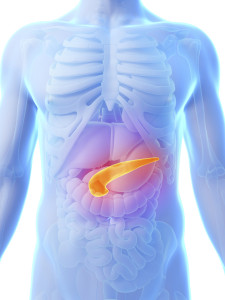Beta Cells Scrutinized at 2015 European Association for the Study of Diabetes (EASD) Annual Meeting
in Research

Observations build a base for preserving beta cell function
 The destruction of pancreatic beta cells underlies the loss of insulin production that characterizes type 1 diabetes (T1D), and research presented during the 51st annual European Association for the Study of Diabetes (EASD) meeting in Stockholm, Sweden, highlighted the multifaceted approach that JDRF is taking to developing beta cell therapies that prevent this destruction.
The destruction of pancreatic beta cells underlies the loss of insulin production that characterizes type 1 diabetes (T1D), and research presented during the 51st annual European Association for the Study of Diabetes (EASD) meeting in Stockholm, Sweden, highlighted the multifaceted approach that JDRF is taking to developing beta cell therapies that prevent this destruction.
In T1D, the immune system launches a misguided attack on insulin-producing pancreatic beta cells, destroying the cells and causing a progressive, currently irreversible loss of insulin production. Many people with T1D have residual beta cell function, however, especially early in disease progression. Finding ways to preserve the health of these residual beta cells will be important to developing interventions that can stop the disease process.
JDRF-supported researchers at Lund University (Malmö, Sweden) analyzed beta cell function in children enrolled in The Environmental Determinants of Diabetes in the Young (TEDDY) project, an ongoing longitudinal study that is following more than 7,000 at-risk children from infancy to 15 years of age to tease out the causes and development of T1D. As lead abstract author Helena Elding Larsson, M.D., Ph.D., reported, their hypothesis that TEDDY participants would be diagnosed earlier in the course of T1D and subsequently would have greater residual beta cell function upon diagnosis than non-study participants proved true. Over time after diagnosis, however, the loss of beta cell function was similar in both groups. The findings suggest that early diagnosis can provide a window of opportunity for preserving residual beta cell function in people with T1D and can provide an opportunity to delay or even prevent the onset of symptomatic disease.
In other abstracts, JDRF-supported investigators presented research findings that could lead to possible approaches for protecting beta cell function. The first study involved the protein cathepsin H (CTSH), which was previously reported to prevent beta cell destruction when expressed in large quantities. Tina Floyel, M.Sc., Ph.D., of Herlev University Hospital, Herlev, Denmark, presented new information about this protective effect, showing that CTSH overexpression was associated with a decrease in expression of Trib3, a gene implicated in beta cell destruction.
Another study looked at the connections between islet cells, which are called gap junctions. Richard Benninger, Ph.D. (University of Colorado, Aurora, CO), reported that disruption of gap junctions occurred before clinical disease in a mouse model of T1D and was associated with islet dysfunction and beta cell destruction with disease progression. In mouse and human islet cells, these harmful effects could be reduced by promoting gap junction formation. Data on the third strategy, presented by Zara Franklin, Ph.D. (King’s College London, London, UK), showed that stimulation of a protein called neuropeptide Y receptor Y1 (NPY Y1) protected mouse islet cells from destruction. Together, these results identify three different beta cell elements—CTSH, gap junctions and NPY Y1—as potential therapeutic targets in T1D.
In another JDRF-supported study aimed at determining and preserving beta cell function, researcher Vineetha Chellakudam (University of Geneva – University of Lausanne, Geneva, Switzerland) reported on an effort to develop imaging techniques for monitoring beta cells. Research to develop beta cell therapies is currently hindered by our inability to observe in a non-invasive manner the health and function of these cells in people. A poster presented at EASD by Ms. Chellakudam described an experimental imaging technique that uses probes that target glucagon-like peptide-1 receptor (GLP-1R) to detect beta cells. The probes performed well when tested in cell cultures, suggesting that they may be promising candidates for imaging beta cells in people.
Why It Matters
Methods of preventing the destruction of pancreatic beta cells or preserving residual beta cells in T1D may be useful in developing interventions that can stop the disease process.
Learn More
To learn more or to support JDRF’s restoration research program, please click here.